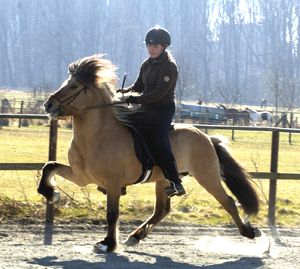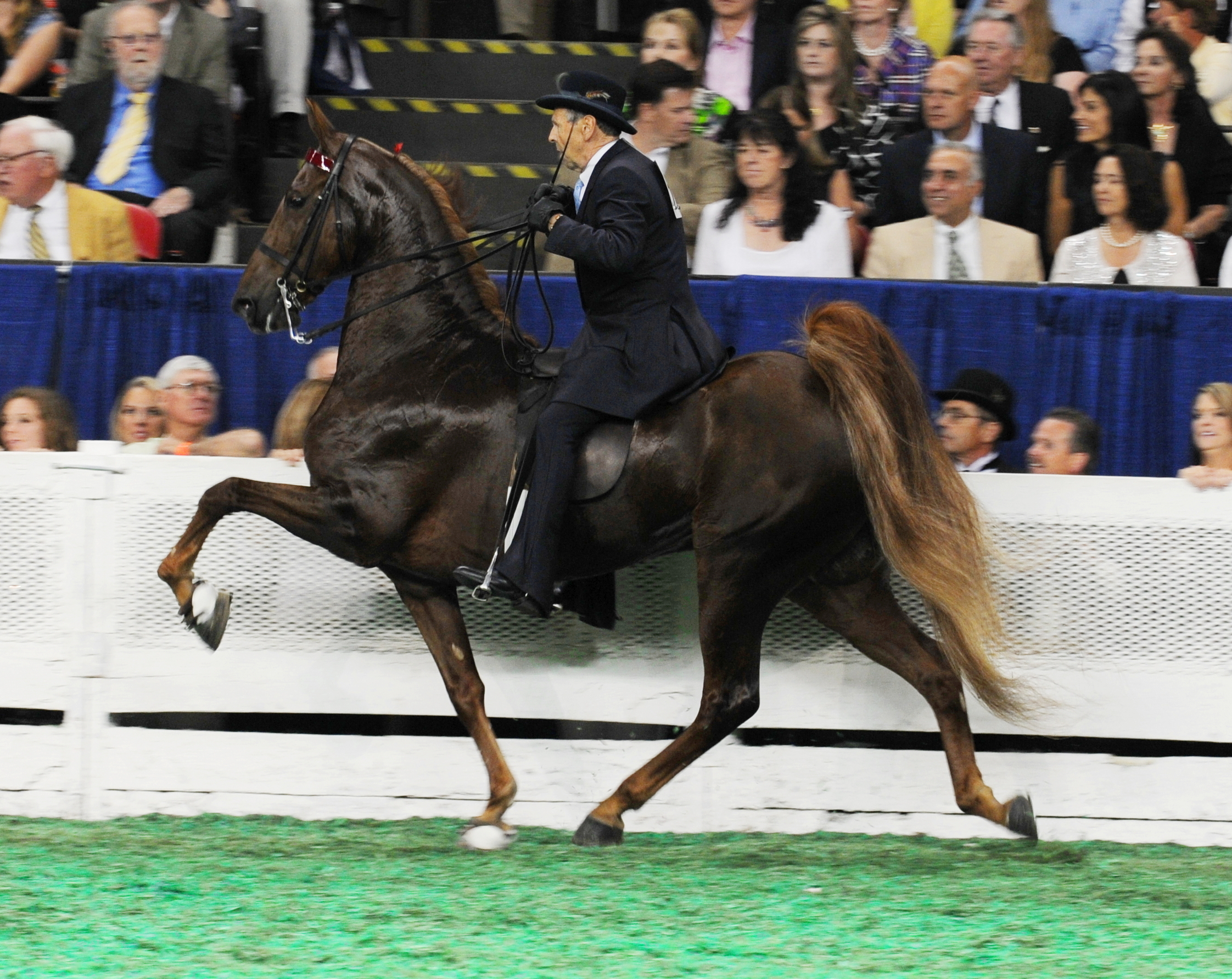|
Rocky Mountain Horse
The Rocky Mountain Horse is a horse breed developed in the state of Kentucky in the United States. Despite its name, it originated not in the Rocky Mountains, but instead in the Appalachian Mountains. A foundation stallion, brought from the western United States to eastern Kentucky around 1890, began the Rocky Mountain type in the late 19th century. In the mid-20th century, a stallion named Old Tobe, owned by a prominent breeder, was used to develop the modern type; today most Rocky Mountain Horses trace back to this stallion. In 1986, the Rocky Mountain Horse Association was formed and by 2005 has registered over 12,000 horses. The breed is known for its preferred "chocolate" coat color and flaxen mane and tail, the result of the relatively rare silver dapple gene acting on a black coat, seen in much of the population. It also exhibits a four-beat ambling gait known as the "single-foot". Originally developed as a multi-purpose riding, driving and light draft horse, today it ... [...More Info...] [...Related Items...] OR: [Wikipedia] [Google] [Baidu] |
Ambling
An ambling gait or amble is any of several four-beat intermediate horse gaits, all of which are faster than a walk but usually slower than a canter and always slower than a gallop. Horses that amble are sometimes referred to as "gaited", particularly in the United States. Ambling gaits are smoother for a rider than either the two-beat trot or pace and most can be sustained for relatively long periods, making them particularly desirable for trail riding and other tasks where a rider must spend long periods in the saddle. Historically, horses able to amble were highly desired for riding long distances on poor roads. Once roads improved and carriage travel became popular, their use declined in Europe but continued in popularity in the Americas, particularly in areas where plantation agriculture was practiced and the inspection of fields and crops necessitated long daily rides. The ability to perform an ambling gait is usually an inherited trait. In 2012, a DNA study found that ... [...More Info...] [...Related Items...] OR: [Wikipedia] [Google] [Baidu] |
Equine Coat Color
Horses exhibit a diverse array of coat colors and distinctive markings. A specialized vocabulary has evolved to describe them. While most horses remain the same color throughout life, a few, over the course of several years, will develop a different coat color from that with which they were born. Most white markings are present at birth, and the underlying skin color of a healthy horse does not change. Some Equine coat colors are also related to the breed of horse, like the Friesian breed for instance. The basic outline of equine coat color genetics has largely been resolved, and DNA tests to determine the likelihood that a horse will have offspring of a given color have been developed for some colors. Discussion, research, and even controversy continues about some of the details, particularly those surrounding spotting patterns, color sub-shades such as "sooty" or " flaxen", and markings. Basic coat colors The two basic pigment colors of horse hairs are pheomelanin ("red") ... [...More Info...] [...Related Items...] OR: [Wikipedia] [Google] [Baidu] |
Tennessee Walking Horse
The Tennessee Walking Horse or Tennessee Walker is a breed of gaited horse known for its unique four-beat running-walk and flashy movement. It was originally developed as a riding horse on farms and plantations in the American South. It is a popular riding horse due to its calm disposition, smooth gaits and sure-footedness. The Tennessee Walking Horse is often seen in the show ring, but is also popular as a pleasure and trail riding horse using both English and Western equipment. Tennessee Walkers are also seen in movies, television, and other entertainment. The breed was developed beginning in the late 18th century when Narragansett Pacers and Canadian Pacers from the eastern United States were crossed with gaited Spanish Mustangs from Texas. Other breeds were later added, and in 1886 a foal named Black Allan was born. He is now considered the foundation sire of the breed. In 1935 the Tennessee Walking Horse Breeders' Association was formed, and it closed the studbook in ... [...More Info...] [...Related Items...] OR: [Wikipedia] [Google] [Baidu] |
American Saddlebred
The American Saddlebred is a horse breed from the United States. This breed is referred to as the "Horse America Made". Descended from riding-type horses bred at the time of the American Revolution, the American Saddlebred includes the Narragansett Pacer, Canadian Pacer, Morgan and Thoroughbred among its ancestors. Developed into its modern type in Kentucky, it was once known as the "Kentucky Saddler", and used extensively as an officer's mount in the American Civil War. In 1891, a breed registry was formed in the United States. Throughout the 20th century, the breed's popularity continued to grow in the United States, and exports began to South Africa and Great Britain. Since the formation of the US registry, almost 250,000 American Saddlebreds have been registered, and can now be found around the world, with separate breed registries established in Great Britain, Australia, continental Europe, and southern Africa. Averaging in height, Saddlebreds are known for their sen ... [...More Info...] [...Related Items...] OR: [Wikipedia] [Google] [Baidu] |
Gaited Horse
Gaited horses are horse breeds that have selective breeding for natural gaited tendencies, that is, the ability to perform one of the smooth-to-ride, intermediate speed, four-beat horse gaits, collectively referred to as ''ambling gaits''. In most "gaited" breeds, an ambling gait is a hereditary trait. This mutation may be a dominant gene, in that even one copy of the mutated allele will produce gaitedness. However, some representatives of these breeds may not always gait. Conversely, some naturally trotting breeds not listed above may have ambling or "gaited" ability, particularly with specialized training. Many horses can both trot and amble, and some horses pace in addition to the amble, instead of trotting. However, pacing in gaited horses is often, though not always, discouraged, though the gene that produces gaitedness appears to also produce pacing ability. Some horses do not naturally trot or pace easily, they prefer their ambling gait for their standard intermediate s ... [...More Info...] [...Related Items...] OR: [Wikipedia] [Google] [Baidu] |
Canter
The canter and gallop are variations on the fastest gait that can be performed by a horse or other equine. The canter is a controlled three-beat gait, while the gallop is a faster, four-beat variation of the same gait. It is a natural gait possessed by all horses, faster than most horses' trot, or ambling gaits. The gallop is the fastest gait of the horse, averaging about . The speed of the canter varies between depending on the length of the horse's stride. A variation of the canter, seen in western riding, is called a lope, and is generally quite slow, no more than . Etymology Since the earliest dictionaries there has been a commonly agreed suggestion that the origin of the word "canter" comes from the English city of Canterbury, a place of pilgrimage in the Middle Ages, as referred to in ''The Canterbury Tales'', where the comfortable speed for a pilgrim travelling some distance on horseback was above that of a trot but below that of a gallop. However a lack of compelli ... [...More Info...] [...Related Items...] OR: [Wikipedia] [Google] [Baidu] |
Trot (horse Gait)
The trot is a ten-beat diagonal horse gait where the diagonal pairs of legs move forward at the same time with a moment of suspension between each beat. It has a wide variation in possible speeds, but averages about . A very slow trot is sometimes referred to as a jog. An extremely fast trot has no special name, but in harness racing, the trot of a Standardbred is faster than the gallop of the average non- racehorse, and has been clocked at over . On June 29, 2014, at Pocono Downs in Pennsylvania the Swedish standardbred Sebastian K trotted a mile in 1 minute, 49 seconds (quarters were passed at 26:2, 55:3 and 1,21:4). This is equivalent to a 1000-pace in 1.07,7 or 53.14 kilometers per hour or 33 miles per hour. From the standpoint of the balance of the horse, the trot is a very stable gait and does not require the horse to make major balancing motions with its head and neck.Harris, Susan E. ''Horse Gaits, Balance and Movement'' New York: Howell Book House 1993 pp. 35–37 Du ... [...More Info...] [...Related Items...] OR: [Wikipedia] [Google] [Baidu] |
Placode
A neurogenic placode is an area of thickening of the epithelium in the embryonic head ectoderm layer that gives rise to neurons and other structures of the sensory nervous system. Placodes are embryonic structures that give rise to structures such as hair follicles, feathers and teeth. The term "neurogenic placode" generally refers to cranial placodes that have neurogenic potential - i.e. those that give rise to neurons associated with the special senses and cranial ganglia. Cranial placodes include a diverse range of structures found across chordates, but the neurogenic placodes found in vertebrates arose later in evolution. In humans The cranial placodes that have neurogenic potential (i.e. give rise to neurons) can be divided into two groups, the dorsolateral placodes and the epibranchial placodes. * dorsolateral placodes includes: ** The trigeminal placode, which consists of ophthalmic and maxillomandibular parts, and gives rise to the cells of the trigeminal ganglion ** Th ... [...More Info...] [...Related Items...] OR: [Wikipedia] [Google] [Baidu] |
Aphakia
Aphakia is the absence of the lens of the eye, due to surgical removal, such as in cataract surgery, a perforating wound or ulcer, or congenital anomaly. It causes a loss of accommodation, high degree of farsightedness (hyperopia), and a deep anterior chamber. Complications include detachment of the vitreous or retina, and glaucoma. Babies are rarely born with aphakia. Occurrence most often results from surgery to remove congenital cataract. Congenital cataracts usually develop as a result of infection of the fetus or genetic reasons. It is often difficult to identify the exact cause of these cataracts, especially if only one eye is affected. People with aphakia have relatively small pupils and their pupils dilate to a lesser degree. Causes Surgical removal of a lens, mainly in cataract surgery, is the most common cause of aphakia. Spontaneous traumatic absorption or congenital absence of lens matter is rare. Traumatic subluxation or dislocation of a lens may cause it. Signs ... [...More Info...] [...Related Items...] OR: [Wikipedia] [Google] [Baidu] |
Microphthalmia
Microphthalmia (Greek: grc, μικρός, mikros, small, label=none, grc, ὀφθαλμός, ophthalmos, eye, label=none, also referred as microphthalmos, is a developmental disorder of the eye in which one (unilateral microphthalmia) or both (bilateral microphthalmia) eyes are abnormally small and have anatomic malformations. Microphthalmia is a distinct condition from anophthalmia and nanophthalmia. Although sometimes referred to as 'simple microphthalmia', nanophthalmia is a condition in which the size of the eye is small but no anatomical alterations are present. Presentation Microphthalmia is a congenital disorder in which the globe of the eye is unusually small and structurally disorganized. While the axis of an adult human eye has an average length of about , a diagnosis of microphthalmia generally corresponds to an axial length below in adults. Additionally, the diameter of the cornea is about in affected newborns and in adults with the condition. The presence of a sm ... [...More Info...] [...Related Items...] OR: [Wikipedia] [Google] [Baidu] |
.jpg)





